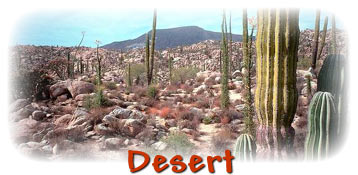
| What is a Desert Like?
The hot desert is a land of extremes: extreme heat and extreme dryness; sudden flash floods and cold nights. Because deserts are such a harsh environment, deserts often have names likes "Death Valley," "the empty quarter," and "the place from where there is no return." Dryness
In most places, rain falls steadily throughout the year. But in the desert, there may be only a few periods of rains per year with a lot of time between rains. When it does rain, there may be quite a downpour! After the rain, desert flowers bloom. Hot During the Day, Cool at Night
Other biomes are insulated by their humidity (water vapor in the air). Temperate deciduous forests, for example, may have 80 percent humidity or more during the day. This water reflects and absorbs sunlight and the energy it brings. At night the water acts like a blanket, trapping heat inside the forest. Since deserts usually have only between 10 and 20 percent humidity to trap temperatures and have so few trees and other vegetation to retain heat, they cool down rapidly when the sun sets, and heat up quickly after the sun rises. Click on one of the following links to check out today's temperature in a desert community:
|